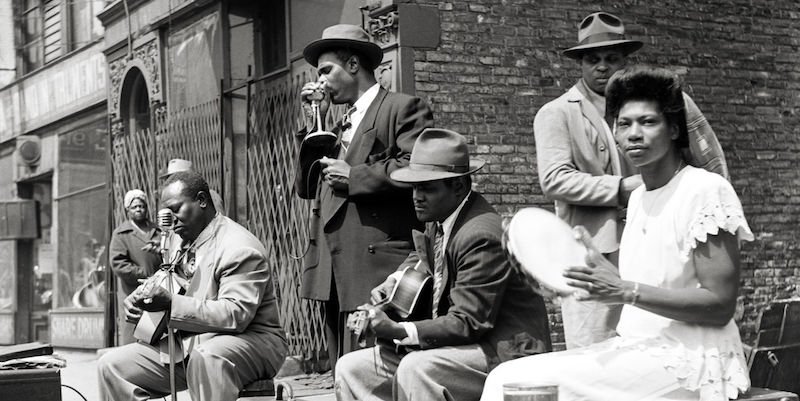
Songs that Evoke a Journey
Often hailed as the universal language, music is a common thread that links even the most disparate societies. No matter the differences, music is a meaningful doorway to understanding and experiencing a new culture.
Just as with food or architecture, a region’s music tells a story: the story of the people and events who have shaped this place. Across the U.S., there are innumerable pockets of musical expression developed by a rich history of mingling cultures. Just as music can be a meaningful part of our modern travels, each American musical style was born out of a history of travels: namely, immigration and moving people groups.
Country Music in Texas

Willie Nelson performs at the Texas Prison Rodeo in the mid-1970s.
The history of country and folk music in Texas dates back to the early 20th century, with the rise of cowboy music, which was a blend of traditional folk songs, ballads, and cowboy poetry. As a mostly rural, agrarian society, the South remained somewhat culturally isolated from the industrialized North. As a result, Texans tended to preserve the traditional folk music of their ancestral homelands– namely folk traditions from the British Isles. However, over time the unique landscape of social and cultural influences in Texas made profound influences on what would come to be country music.
By the time Texas joined the United States in 1845, the original Native American and Hispanic inhabitants had been joined by an astounding array of other immigrant and ethnic groups, including Anglo, Irish, German, and African to name a few. The rugged environment of the western frontier encouraged cooperation between this polyphony of different groups in order to survive, and musical influences were exchanged in the process. Cowboys and cattle drives from Texas to the Midwest played a huge role in shaping the subject of many country tunes: stories sung by the campfire about life on the open range.
Pairs well with: A Private Ranch Road Trip in West Texas
Jazz in New Orleans

New Orleans is widely considered the birthplace of jazz music, and the city’s musical heritage is steeped in this dynamic musical style. In the late 19th century, a unique fusion of African rhythms, European instruments, and African-American and Creole musical traditions coalesced in the lively cultural melting pot of New Orleans. From the improvisational stylings of brass bands and the syncopated rhythms of ragtime to the soulful sounds of blues and gospel, jazz emerged as an innovative and influential art form. Legendary figures like Louis Armstrong, Jelly Roll Morton, and Sidney Bechet honed their craft in the city, shaping the distinct sounds of New Orleans jazz and forever leaving their mark on the history of music.
Pairs well with: The Best of New Orleans and Cajun Country
For more music from Louisiana, check out our ‘Sounds of the South’ playlist here.
Blues in Chicago

The history of blues music in Chicago is deeply intertwined with the Great Migration, a significant demographic shift of African Americans from the rural South to urban centers in the North. As thousands of African Americans settled in Chicago during the early 20th century, they brought with them their musical traditions, including the blues. Blues music in Chicago gave voice to African-American experiences and struggles. It served as an outlet for expressing emotions and addressing social issues. Blues artists like Muddy Waters, Howlin’ Wolf, and Willie Dixon became prominent figures in the Chicago blues scene. Sometimes mistaken for jazz, the blues genre is distinguished by a smaller ensemble, often featuring guitar, harmonica, piano, bass, and drums. The emphasis is on individual expression through vocals and instrumental solos, but improvisation is relatively limited compared to jazz.
Folk Music in the Appalachians

Folk music has a long and rich history in the Appalachian region of the United States, stretching back to the early 18th century. The early folk music of Appalachia was largely based on the ballad tradition, with songs that told stories of love, loss, and adventure. During the 19th century, the coal mining industry brought many people from different parts of the United States and Europe to Appalachia, and with them came new musical influences. African American blues and gospel music, as well as Irish and Scottish fiddle tunes, began to blend with the traditional ballads of Appalachia, creating a new, distinct style of folk music.
Rock and Roll in Memphis

Memphis is often referred to as the “Birthplace of Rock ‘n’ Roll” due to the groundbreaking recordings and artists associated with the city. The pioneering work of musicians like Elvis Presley, Jerry Lee Lewis, and others at Sun Studio in the 1950s helped shape the early sound of rock ‘n’ roll. These artists fused elements of blues, country, gospel, and R&B to create a new and dynamic musical style. The emergence of rock ‘n’ roll coincided with cultural shifts and the rise of a distinctive youth culture in post-World War II America, providing the space for rock and roll’s rebellious and energetic edge to thrive.
